可信还是误导?地点脉动2.0数据集在中国城市景观主观感知预测中的自适应评价
IF 7
1区 经济学
Q1 DEVELOPMENT STUDIES
引用次数: 0
摘要
视觉感知在以人为中心的空间研究中至关重要。目前,城市空间主观评分广泛采用地点脉冲数据集。然而,由于数据来源和参与者的限制,其局部适用性提出了问题。本研究比较了Place Pulse 2.0和深圳本地数据集在预测感知方面的表现,探讨了其在评估中国特大城市方面的可行性。采用k-means聚类方法将深圳市街景图像划分为5个空间类型,并将每个空间类型的400个街景图像编成一个由当地居民打分的数据集。使用XGBoost预测基于不同预训练数据集的感知分数。研究发现,数据集之间的城市感知评价存在显著差异。Place Pulse数据集倾向于对“无聊”和“令人沮丧”等负面看法给出更悲观的评级。在“活泼”和“安全”等正面印象方面,它表现一般,但在“美丽”和“富有”方面表现良好。此外,感知差异在城市核心、绿色走廊和城中村最为明显。由于建筑立面的同质化和封闭感,城中村“令人沮丧”的感觉有所增加。其新颖之处在于量化了空间集群间的感知差异,并阐述了它们与视觉环境的关系。该研究挑战了全球城市地点脉动数据集的普适性,为中国的局域空间感知研究提供了更可信的数据库和框架。本文章由计算机程序翻译,如有差异,请以英文原文为准。
Plausible or misleading? Evaluating the adaption of the place pulse 2.0 dataset for predicting subjective perception in Chinese urban landscapes
Visual perception is crucial in human-centric spatial studies. Currently, Place Pulse dataset is widely used for subjective scoring of urban space. However, its local applicability raises questions due to limitations in data sources and participants. This study compares the performance of Place Pulse 2.0 and a local dataset from Shenzhen in predicting perceptions, exploring its feasibility for evaluating Chinese megacities. Street view images (SVIs) in Shenzhen were categorized into five spatial types using k-means clustering for refined differentiation, and 400 SVIs from each category were compiled into a dataset rated by local residents. Perception scores based on different pre-trained datasets were predicted using XGBoost. The study found notable differences in urban perceptual evaluation between the datasets. Place Pulse dataset tended to give more pessimistic ratings for negative perceptions like “boring” and “depressing”. For positive perceptions such as lively and safe, it performed moderately, but well in beautiful and wealthy. Additionally, perceptual differences were most pronounced in urban core, green corridors, and urban villages. Urban villages saw an increase in perceptions of being "depressing" due to the homogeneity of building facades and a sense of enclosure. The novelty lies in quantifying perceptual differences across spatial clusters and elaborating their relationship with the visual environment. This research challenges the universality of the Place Pulse dataset in global cities and provides a more credible database and framework for localized spatial perception research in China.
求助全文
通过发布文献求助,成功后即可免费获取论文全文。
去求助
来源期刊

Habitat International
Multiple-
CiteScore
10.50
自引率
10.30%
发文量
151
审稿时长
38 days
期刊介绍:
Habitat International is dedicated to the study of urban and rural human settlements: their planning, design, production and management. Its main focus is on urbanisation in its broadest sense in the developing world. However, increasingly the interrelationships and linkages between cities and towns in the developing and developed worlds are becoming apparent and solutions to the problems that result are urgently required. The economic, social, technological and political systems of the world are intertwined and changes in one region almost always affect other regions.
 求助内容:
求助内容: 应助结果提醒方式:
应助结果提醒方式:


